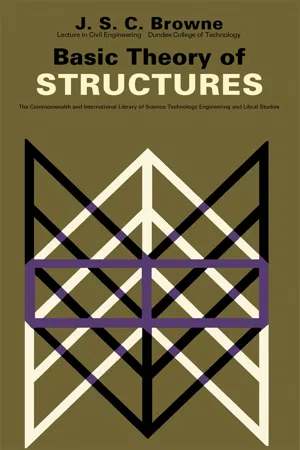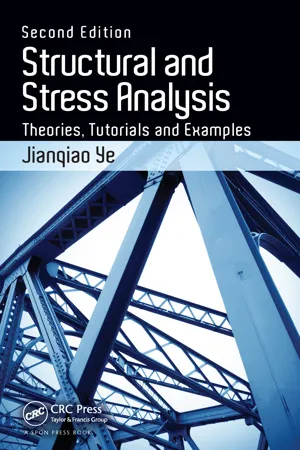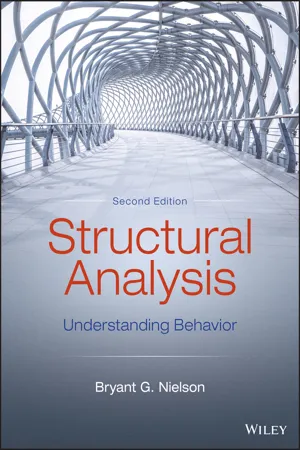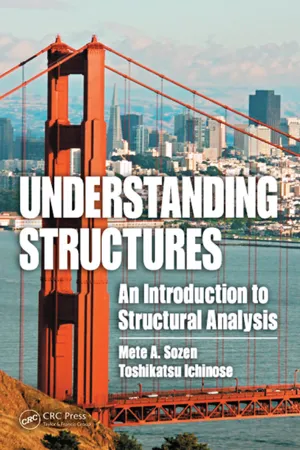Technology & Engineering
Shear and Moment Diagrams
Shear and moment diagrams are graphical representations used in structural engineering to analyze the internal forces and moments within a structural element, such as a beam. The shear diagram shows the variation of shear force along the length of the beam, while the moment diagram illustrates the variation of bending moment. These diagrams are essential for understanding the behavior and design of structural components.
Written by Perlego with AI-assistance
Related key terms
1 of 5
10 Key excerpts on "Shear and Moment Diagrams"
- eBook - PDF
Basic Theory of Structures
The Commonwealth and International Library: Mechanical Engineering Division
- J. S. C. Browne, N. Hiller, G. E. Walker(Authors)
- 2014(Publication Date)
- Pergamon(Publisher)
Such diagrams are, of course, only applicable for one particular loading and if the loading is moved or changed new diagrams must be constructed. Shearing force and bending moment diagrams have a num-ber of uses, and the most obvious is that they enable the engi-neer to see at a glance where the shearing or bending is great-est and so simplify the task of checking that the beams have adequate strength at every section to resist the applied shear-ing forces and bending moments. Shearing force diagrams usually provide the quickest means of obtaining bending moment diagrams for statically deter-minate beams, by using the area under them to determine the bending moment. Example 2 A. Beam with non-central load. The simple beam in Fig. 2.6 carries a load Wplaced at a distance a from the left end. Sketch the s.f. and b.m. diagrams. The first step is to determine the reactions at the supports. By taking moments about B, we find that the reaction at A is Wb/l and similarly by taking moments about A the reaction at B is found to be Wa/l. It is worth checking at this stage that the sum of the two reactions is equal to the total load W. The shearing force between A and C is constant, and is merely equal to the reaction at A; similarly the shearing force bet-ween C and B is equal to the reaction at B. Hence, to construct the shearing force diagram we start at the left-hand end of the base line AB, and go upwards by an amount equal to the force applied at A, i.e. the reaction Wb/l; run along horizont- 50 BASIC THEORY OF STRUCTURES ally until we meet the load, drop downwards by the amount of the load W, and continue horizontally until we meet the right-hand reaction, where we move upwards by an amount Wajl, which brings us back on to the base line and completes the shearing force diagram. - eBook - PDF
- Barry Goodno, James Gere, Barry Goodno(Authors)
- 2020(Publication Date)
- Cengage Learning EMEA(Publisher)
Combine steps as needed for an efficient solution. Copyright 2021 Cengage Learning. All Rights Reserved. May not be copied, scanned, or duplicated, in whole or in part. Due to electronic rights, some third party content may be suppressed from the eBook and/or eChapter(s). Editorial review has deemed that any suppressed content does not materially affect the overall learning experience. Cengage Learning reserves the right to remove additional content at any time if subsequent rights restrictions require it. Section 4.5 Shear-Force and Bending-Moment Diagrams 419 1,2. Conceptualize, Categorize: Reactions: From a free-body diagram of the entire beam, find the vertical reaction R B (positive when upward) and the moment reaction M B (positive when counterclockwise in a statics sign convention): 5 1 5 2 1 ( ) 1 2 1 2 R P P M PL P b B B (4-28a,b) Shear forces and bending moments: Find the shear forces and bending moments by cutting through the beam in each of the two segments, drawing the corresponding free-body diagrams, and solving the equations of equilib- rium to obtain 5 2 5 2 , , (0 ) 1 1 V P M Px x a (4-29a,b) 5 2 2 5 2 2 2 , , ( ) ( ) 1 2 1 2 V P P M Px P x a a x L (4-30a,b) 3. Analyze: The corresponding shear-force and bending-moment diagrams are shown in Figs. 4-34b and c. The shear force is constant between the loads and reaches its maximum numerical value at the support, where it is equal numeri- cally to the vertical reaction R B [Eq. (4-28a)]. The bending-moment diagram consists of two inclined straight lines, each having a slope equal to the shear force in the corresponding segment of the beam. The maximum bending moment occurs at the support and is equal numerically to the moment reaction M B [Eq. (4-28b)]. It is also equal to the area of the entire shear-force diagram, as expected from Eq. (4-6). 4. Finalize: The shear diagram is constant between applied loads, so the moment diagram must be linear between these same load points. - eBook - PDF
- Timothy A. Philpot(Author)
- 2014(Publication Date)
- Wiley(Publisher)
Step 2 — Construct the Shear-Force Diagram: The shear-force diagram will be con- structed directly beneath the load diagram. For that reason, it is convenient to draw a series of vertical lines beneath significant beam locations to help align the diagrams. Begin the shear-force diagram by drawing a horizontal axis, which will serve as the x axis for the V diagram. The shear-force diagram should always start and end on the value V 0. Construct the V diagram from the leftmost end of the beam toward the rightmost end, using the rules outlined on p. 231. Rules 1 and 2 will be the rules most frequently used to determine shear-force values at important points. Rule 3 is useful when sketching the proper diagram shape between these key points. Label all points where the shear force changes abruptly and locations where maximum or minimum (i.e., maximum negative values) shear forces occur. Step 3 — Locate Key Points on the Shear-Force Diagram: Special attention should be paid to locating points where the V diagram crosses the V 0 axis, because these points indicate locations where the bending moment will be either a maximum or a minimum value. For beams with distributed loadings, Rule 3 will be essential for this task. Step 4 — Construct the Bending-Moment Diagram: The bending-moment dia- gram will be constructed directly beneath the shear-force diagram. Begin the bending- moment diagram by drawing a horizontal axis, which will serve as the x axis for the M diagram. The bending-moment diagram should always start and end on the value M 0. Construct the M diagram from the leftmost end of the beam toward the rightmost end, using the rules outlined on p. 225. Rules 4 and 6 will be the rules most frequently used to determine bending-moment values at important points. Rule 5 is useful when sketching the proper diagram shape between these key points. - eBook - PDF
Structural and Stress Analysis
Theories, Tutorials and Examples, Second Edition
- Jianqiao Ye(Author)
- 2015(Publication Date)
- CRC Press(Publisher)
The change rate of bending moment along a beam is equal to the shear force dM x dx V x ( ) ( ) = (4.2) 3. The combination of Equations 4.1 and 4.2 yields d M x dx q x 2 2 ( ) ( ) = -(4.3) The above relationships are applicable at all cross sections of a beam except where there is a concentrated force or moment. 4.6 SHEAR FORCE AND BENDING MOMENT DIAGRAMS The shear force and bending moment diagrams show, respectively, the internal shear force and bending moment distribution on the cross section along the length of a beam. On the basis of the interrelations shown in Section 4.5, Table 4.2 shows some common features exhibited in the shear force and bending moment diagrams of beams. V q ( x ) Arbitrary section (a) (b) M x Figure 4.5 Internal forces of loaded beam. + Arbitrary section (b) (a) Positive bending moment Figure 4.4 Sign convention of bending moment. Shear and bending moment 65 4.7 KEY POINTS REVIEW • A beam is long in the axial direction compared to its other two dimensions. • A beam is to support external load applied perpendicular to the axis. • The two major internal forces are shear force and bending moment. • The change in shear force is equal to applied distributed load. • The change in bending moment is equal to shear force. • A shear force diagram shows how shear force is distributed along the axis of a beam. • A bending moment diagram shows how bending moment is distributed along the axis of a beam. • Continuous distribution of applied loads results in continuous variations of both shear force and bending moment along a beam. • On unloaded segments of a beam the shear force is constant. • A uniformly distributed load causes a linear variation in shear force, and a parabolic varia-tion in bending moment. • A concentrated force/moment results in sudden drop or jump of shear force/bending moment at the location where the force/moment is applied. • A point force causes a kink in a bending moment diagram. - eBook - ePub
- Robert L. Mott, Joseph A. Untener(Authors)
- 2021(Publication Date)
- CRC Press(Publisher)
concentrated moment resulting in an abrupt change in the value of the bending moment by the amount of the applied moment, 5.24 kN · m, thus resulting in the peak value of 11.02 kN · m. Here is the convention used:Conventions for Concentrated Moments-
When a concentrated moment is clockwise , the moment diagram rises .
-
When a concentrated moment is counterclockwise , the moment diagram drops .
Between B and C , the moment decreases to zero because of the negative shearing force and the corresponding negative area under the shearing force curve.5–11 Mathematical Analysis of Beam Diagrams
For most practical problems, the methods for preparing the load, shearing force, and bending moment diagrams, using the techniques shown earlier in this chapter, are adequate and convenient. A wide variety of beam types and loadings can be analyzed with sufficient detail to permit the logical design of the beams to ensure safety and to limit deflections to acceptable values. The methods of accomplishing these objectives are presented in Chapters 7 through 11 .However, there are some types of loading and some types of design techniques that can benefit from the representation of the load, shearing force, and bending moment diagrams by mathematical equations. This section presents the methods of creating such equations.The following guidelines are for writing sets of equations that completely define the load, shearing force, and bending moment as a function of the position on the beam:Guidelines for Writing Beam Diagram Equations- Draw the load diagram showing all externally applied loads and reactions.
- Compute the values for all reactions.
- Label points along the length of the beam where concentrated loads are applied or where distributed loads begin or end.
- Draw the shearing force and bending moment diagrams using the techniques shown earlier in this chapter, noting values at the critical points defined in step 3.
-
Establish conventions for denoting positions on the beam and signs of shearing forces and bending moment. In most cases, we will use the following conventions (see Figures 5–21 through 5–33
- eBook - PDF
Mechanical Engineering Science
In SI Units
- J. L. Gwyther, W. D. Brown, G. Williams(Authors)
- 2014(Publication Date)
- Butterworth-Heinemann(Publisher)
Summary 1. A bending moment diagram may consist of either straight lines or curved lines, or a combination of the two. 2. For concentrated loads the diagram consists of inclined straight lines, the bending moment at extremities which are 'free' having always a zero value. 3. For a distributed load the diagram consists of a curved line. Again the bending moment at 'free' extremities is zero. 4. The vertical height of the diagram at a section represents to scale the bending moment at that section. Above the datum (or zero) line the bending moment is positive; below it is negative. Calculation of the magnitudes of the reactions This has already been dealt with incidentally (p. 129) but is repeated here because of its importance. For the purpose of explaining the meaning of shearing force and bending moment, examples of simply supported beams have been chosen in which the loads were symmetrical on either side of a central vertical axis. In these examples it can be argued, merely from visual observa-tion, or from symmetry, that the values of the reactions at the supports are equal. It is not often that such simple cases arise, and so it becomes Beams — Shearing Force and Bending Moment 185 necessary frequently to calculate the values of the reactions. This must always be done when the load distribution is not uniform. In order to calculate these values consider the equilibrium of the whole beam. Because all the external forces on the beam are vertical, and therefore parallel, the conditions of equilibrium are: 1. All the vertical forces must balance. That is, the sum of all the upward forces must equal the sum of all the downward forces. 2. The algebraic sum of the moments of all the forces about any point must be zero. Here it is necessary to emphasize the distinction between the cal-culation of a bending moment at any point and taking moments about the point. - No longer available |Learn more
- D. Kumar, Sarhan M. Susa(Authors)
- 2022(Publication Date)
- Mercury Learning and Information(Publisher)
2 SHEAR FORCE AND BENDING MOMENTA beam is a structural member of which longitudinal dimension is large compared to the transverse dimension. The beam is supported along its length and is acted upon by a system of loads at right angles to its axis. Due to external loads and couples, shear force and bending moment develop at any section of the beams. For the design of beams, information about the shear force and bending moment are desired. Accordingly, it is appropriate to learn about the variation of shear force and bending moment along the length of the beam.2.1. SHEAR FORCE AND BENDING MOMENTConsider a simply supported beam acted upon by different point loads as shown in Figure 2.1 .FIGURE 2.1.The loads are transferred to supports and for equilibrium conditions:R a + R b = W 1 + W 2 + W 3 = 30 + 20 + 20 = 60 kN.Also Σ M a (moments about support A ) = 0. That givesImagine the beam to be cut at an arbitrary section xx at distance x = 4 m from the end A and draw separately the free-body diagrams of the two portions (Figure 2.2 ).● Considering equilibrium of forces on each portion of the beam, the net resultant vertical forces areFIGURE 2.2.It is to be noted that forces on the left and right sides of section xx are equal in magnitude but opposite in direction.Obviously, section xx is subjected to a force of 10 kN which is trying to shear the beam. The force of 10 kN is called as shear force at section xx .“Shear force at a section in a beam is the force that is trying to shear off the section. It is obtained as algebraic sum of all the forces acting normal to the axis of beam; either to the left or to the right of the section.”● Considering equilibrium of moments on each portion of the beam:It is to be noted that moments on the left and right sides of section xx are equal in magnitude but opposite in direction. Obviously, section xx is acted upon by a moment of 50 kNm. Since this moment is trying to bend the beam, it is called the bending moment - eBook - PDF
- William M.C. McKenzie(Author)
- 2013(Publication Date)
- CRC Press(Publisher)
Figure 4.10 The full shear force diagram can therefore be drawn as shown in Figure 4.11. Shear Force Diagram Figure 4.11 The same result can be obtained by considering sections from the right-hand side of the beam. 4 kN 4 kN 4 kN 4 kN 4 kN V A =10 kN V G = 10 kN A B C D E F G 6 @ 600 mm = 3600 mm 6 kN 10 kN 10 kN 10 kN 6 kN 6 kN 2 kN 2 kN 10 kN +ve − ve 600 mm 6 kN 10 kN 10 kN 4 kN secondary beam 10 kN B A B eams 163 4.1.3 Bending Moment Diagrams In a statically determinate beam the numerical value of the bending moment (i.e. moments caused by forces which tend to bend the beam) can be obtained by evaluating the algebraic sum of the moments of the forces to one side of a section. In the same manner as with shear forces either the left-hand or the right-hand side of the beam can be considered. The convention adopted in this text to indicate positive and negative bending moments is shown in Figures 4.12(a) and (b). Bending inducing tension on the underside of a beam is considered positive . Figure 4.12 (a) Bending inducing tension on the top of a beam is considered negative . Figure 4.12 (b) Note: Clockwise/anti-clockwise moments do not define +ve or − ve bending moments. The sign of the bending moment is governed by the location of the tension surface at the point being considered. As with shear forces the calculation for bending moments can be carried out at various locations along a beam and the values plotted on a graph; this graph is known as the ‘ bending moment diagram ’. The bending moment diagram indicates the variation in the bending moment along a structural member. Consider sections between A and B of the beam as before: 0 < x < 600 mm In this case when x = 600 mm the 4.0 kN load passes through the section being considered and does not produce a bending moment, and can therefore be ignored. 10 kN A B x 4 kN or +ve bending tension on underside X X tension on underside X X tension on top tension on top or − ve bending X X X X - eBook - PDF
Structural Analysis
Understanding Behavior
- Bryant G. Nielson(Author)
- 2022(Publication Date)
- Wiley(Publisher)
If shear is present in the 2 axis (noted as 2—2) then it will produce a moment about the 3—3 axis. If shear is present in the 3—3 direction then it will cause a moment about the 2—2 direction. It is most common for planar (2D) structures for the shear to develop in the 2—2 direction and the moment in the 3—3 direction. VIEWING MEMBER LOCAL AXES Clicking the check box symbol found in the upper ribbon in the SAP window will open a dialog box. This box will have many display options available including the display of local axes for Frames/Cables/Tendons. A few key points about viewing Shear and Moment Diagrams in SAP2000 are made below. • It is usually helpful to show moment values on the diagrams. Select the radio button shown in the lower-left hand corner of Figure 6.7. • Select the relevant load case in the upper-right hand corner of Figure 6.7. Most often there will only be one case to choose: Dead. • Shear diagrams are plotted just opposite from the way they are constructed and presented in this text. This variation should simply be understood and accepted. It does not change the value of the shear though. DID YOU KNOW? Constructing 2D structures in the X—Z plane will prevent the student from being confused about the local axes. This will mean that shear will occur in the 2—2 direction and moment will occur in the 3—3 direction. Q U I C K N O T E The global units you have set at the time of table generation will dictate the units which are reported in the tables. Units can be changed through the pull-down box located in the lower-right hand corner of the SAP2000 window. FIGURE 6.8 Table output dialog box for SAP2000. 6.10 SAP2000 Computer Applications 145 • Moment diagrams are plotted on the tension side of the member by default. This is opposite of what is generated in this text, which produces moment diagrams on the compression side of the member. One does have the option of changing this setting by going to the following pull-down menu selection. - eBook - PDF
Understanding Structures
An Introduction to Structural Analysis
- Mete A. Sozen, Toshikatsu Ichinose(Authors)
- 2018(Publication Date)
- CRC Press(Publisher)
While the part of the beam to the left of the cut is subjected to a downward shear force and counterclockwise bending moment ( Figure 2.2.1b ), the part of the beam to the right of the cut is subjected to an upward shear force and clockwise bending moment as shown in Sketch (a) below. Shear force is not a vector but a set of two forces shown in Sketch (b) below. Its effect is similar to that of a pair of shears (or scissors). We shall revisit this topic at the end of this section. (a) Left of section (b) Shear V M 90 Understanding Structures: An Introduction to Structural Analysis Move your cursor to any grid and click. The shear force remains at 10 N, while the bending moment varies. For example, at a distance of 40 mm from the beam end, the moment acting on the section is 400 N-mm ( Figure 2.2.2 ). Let the distance from the free end to the section be x ( Figure 2.2.3a ). Equilib-rium of moments of the free body shown in Figure 2.2.3b leads to M = V.x (2.2.1) Bending moment M is distributed as shown in Figure 2.2.3c : it is zero at the free end ( M = 0 at x = 0) and increases linearly to the fixed end ( M = V.L at x = L ). The symbol ∪ in the diagram is used to indicate that the bending moment compresses the top fiber of the beam. 11.85 10 (a) Intial window –10 1000 11.85 10 (b) Free body –10 800 10 FIGURE 2.2.1 Beam with load at the free end. 11.85 10 400 10 –10 FIGURE 2.2.2 Shear force and bending moment at a section. Moments and Deflections in Cantilever Beams 91 Differentiating Equation 2.2.1 with respect to x , we obtain dM/dx = V (2.2.2) This relationship is very important because it is valid for any beam or column subjected to any set of loads. Equation 2.2.2 states that the rate of change of moment with distance is the shear force. Conversely, the integration of shear over a distance results in moment.
Index pages curate the most relevant extracts from our library of academic textbooks. They’ve been created using an in-house natural language model (NLM), each adding context and meaning to key research topics.









